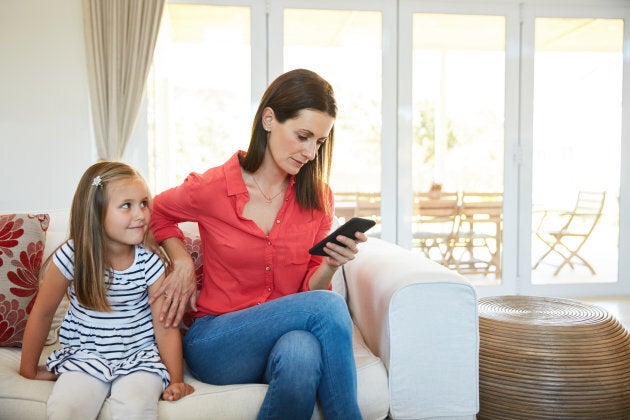
Recently, pediatrician Dr. Steve Silvestro, host of The Child Repair Guide podcast, put out a challenge to parents called #PhoneDownParentUp. The challenge asks parents to spend one weekend using their phones only for important calls or driving directions — no texting, no social media. The idea is to give attention to our children instead of our technology.
Many (including myself) took on the challenge, with surprising results. Initially we felt very anxious but by the end of the weekend we were all committed to breaking up with our phones.
Most of us have no idea how intrusive and overbearing our relationships with our phones have become until we take a step back and reevaluate it.
More from HuffPost Canada:
A 2017 study found that the average American checks their phone on average once every 12 minutes. The research also found that 31 per cent of the study participants felt regular anxiety when separated from their phone, and 60 per cent reported feeling stressed out when their phone was turned off or was out of reach.
During an Apple conference in 2016, Ben Bajarin, an analyst for the tech website Techpinions, said that the average iPhone user unlocked their device 80 times a day, meaning that they looked at their device an average of six to seven times an hour, provided they used their Apple device for 12 hours a day.

We are a generation of tech-distracted parents. In fact, research published in the Journal of Child Development reported findings that parents who were highly tech-distracted had children with higher rates of acting out through misbehaviours, attention seeking and aggression. Children of tech-distracted parents also showed higher rates of depression and anxiety.
While mobile devices allow us the freedom to work remotely from a child's soccer game, there is a dark side to the flexibility that our mobile devices afford us; namely we get sucked in.
Our attention is drawn away to check the non-urgent and mundane emails, too. We post our kids' soccer pictures on social media, but since we have Instagram open we check our feed and comment on another person's post. "Oh shoot, he scored! I was looking down at my phone and missed it." Grumpy face emoji.
Social media developers know how to get people sucked into their apps. Likes, shares, colours, notifications, and auto-starts are all created to purposefully activate the reward circuitry of the brain and to get your dopamine neurotransmitters flowing.
When we suffered the initial withdrawal symptoms from initially putting our devices down for the #PhoneDownParentUp challenge, we realized that the word "addiction" could accurately describe our relationship with technology.
However, by day two, parents — myself included — noticed that we had so much more free time. We started to feel more relaxed than we had in years and our children got more engagement from us. One parent even reported that work issues came up and resolved themselves without needing her.
So, would you like to be conscious about your time and use tech as a tool in your life instead of having it hijack you? Here are some starter steps:
- It all starts with awareness. See if you can do the 48-hour no-phone weekend challenge and pay attention to how you feel and behave differently.
- Turn your phone to black and white so those flashy colours aren't engaging your eyes.
- Turn off notifications. Who can resist looking when you hear a ping?
- Practice docking the phone. Pick hours that you will absolutely not touch your phone. Start with the easy times (like while eating dinner or tucking kids in) and lengthen the time and frequency gradually.
- Don't take your phone with you. You can actually go to the park or the mall and not have your phone on you. If an emergency happens, people will find you.
- Manage your home screen so you only see functional apps like maps or the weather. Move games and social media to your second (or third) screens.
- Decide what times of day you will be on social media. Get in and get out. Use a time tracking device like Moments to measure objectively how long you are on which of your apps. Some allow you to pre-set the amount of time you wish to be on the app before kicking you off and blocking you out.
- Remind yourself what is important to you. We all have the same 24 hours — don't let those hours be spent in a mindless default mode. Instead, post pictures and notes around your house so you are reminded to make a more conscious choice of how you spend this one precious day.
Also on HuffPost: